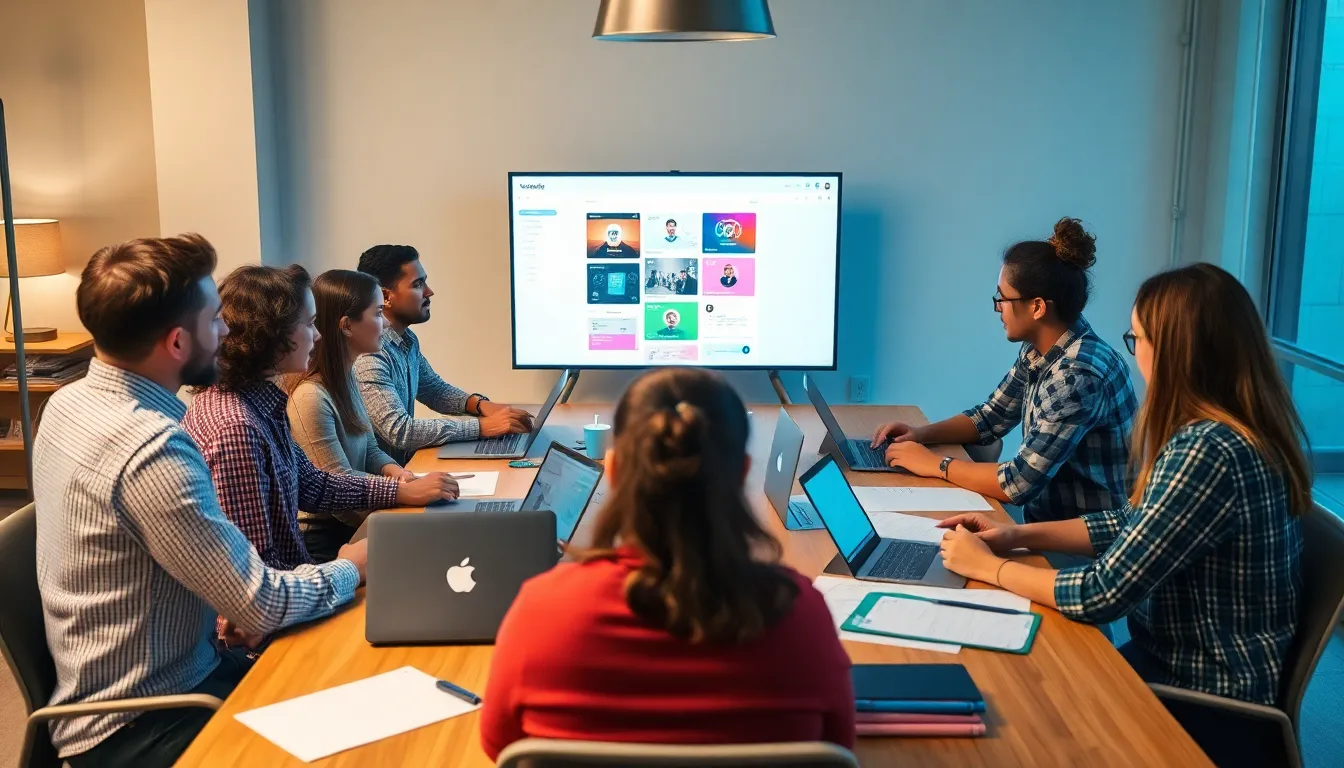In a world where everyone seems to have a smartphone glued to their hand, app design tools are the secret sauce behind the next big thing. Whether it’s a game that keeps you glued to your screen or an app that helps you find the nearest taco truck, the right tools can turn a wild idea into a digital masterpiece.
Table of Contents
ToggleOverview Of App Design Tools
App design tools play a crucial role in the development process of mobile applications. These tools streamline workflows, helping designers create user interfaces and enhance user experiences effectively. Various categories of app design tools address different aspects of the design process.
Wireframing tools enable designers to sketch out app layouts before delving into detailed design. Popular options include Sketch, Adobe XD, and Figma. Each provides unique features for rapid prototyping and feedback collection.
Prototyping tools focus on turning static wireframes into interactive models. Tools like InVision and Axure allow designers to simulate app navigation and test user interactions. Feedback from stakeholders becomes more accessible, leading to better-informed decisions.
Collaboration tools are essential for various team members to share insights and work cohesively. Platforms such as Miro and Notion facilitate brainstorming and documentation, ensuring all team members are on the same page. Organized workflows contribute to the overall success of app projects.
Design systems and libraries ensure consistency across app interfaces. Tools like Material-UI and Bootstrap provide pre-designed components, enabling designers to maintain uniformity and speed up the design process. Sticking to a design system reduces inconsistencies and enhances usability.
Accessibility tools enhance the inclusivity of app designs. These tools evaluate designs for color contrast, text size, and navigation ease. By prioritizing accessibility, designers create apps that cater to diverse user needs.
Choosing the right combination of app design tools significantly impacts the overall efficiency and quality of the final product, making it essential to assess specific project requirements before selection.
Key Features To Consider


When selecting app design tools, certain features significantly enhance both the design process and final output. Evaluating these features can lead to more efficient workflows and improved user experiences.
User Interface Design
User interface design tools must prioritize ease of use and functionality. Intuitive drag-and-drop interfaces often streamline the design process. Customizable templates allow designers to maintain brand consistency effectively. Tools like Figma and Adobe XD excel in providing interactive components, ensuring a seamless design experience. Accessibility features also play a crucial role. They help designers ensure their apps are usable by everyone, thus reaching a broader audience.
Collaboration Features
Collaboration features are essential when multiple team members are involved in app design. Real-time editing allows for instant feedback, which fosters creative brainstorming sessions. Commenting and version control enhance communication and keep track of design changes. Tools such as Miro facilitate remote collaboration, making it easy for distributed teams to share ideas. Integration with project management software ensures teams stay organized throughout the design process. These functionalities reduce miscommunication and boost project efficiency.
Prototyping Capabilities
Prototyping capabilities transform static designs into interactive experiences. Tools like InVision allow designers to simulate user interactions, providing valuable insights into app flow. Iteration capabilities enable teams to quickly test and refine designs. Testing prototypes with real users uncovers areas for improvement early on. Flexibility in design adjustments helps adapt to user feedback effectively. A robust prototyping tool can significantly enhance the overall design cycle, ensuring the final product resonates with users.
Popular App Design Tools
Various app design tools streamline the development process and enhance user experiences. Each tool provides unique features that cater to specific design needs.
Tool 1: Overview and Features
Sketch serves as a powerful vector design tool tailored for app interfaces. This platform excels in creating precise layouts and components. Collaborators often appreciate its shared libraries that ensure design consistency. Features like symbols and responsive resizing enhance productivity. Designers can quickly iterate through projects thanks to its user-friendly interface. Moreover, integration with plugins expands its functionality beyond standard features.
Tool 2: Overview and Features
Adobe XD simplifies the design and prototyping process for apps. This tool allows users to create wireframes and interactive prototypes seamlessly. The robust sharing capabilities enable teams to gather feedback efficiently. Elements like voice integration and auto-animation promote creativity in designs. Designers benefit from integrations with other Adobe Creative Cloud tools, enhancing workflow management. Real-time collaboration features make it easier to work with multiple stakeholders.
Tool 3: Overview and Features
Figma stands out with its web-based platform that supports real-time collaboration. Offering a design system ensures uniformity across projects while enabling easy updates. This tool allows for easy prototyping and feedback loops, which speed up the design process. Designers often favor its extensive library of components that streamline design tasks. Additionally, Figma’s cross-platform compatibility enables access from various devices. Users appreciate the integrated commenting feature that simplifies communication throughout the design process.
Pros And Cons Of App Design Tools
App design tools offer various benefits and some limitations. Understanding these aspects aids in making informed decisions about their usage.
Advantages Of Using App Design Tools
Increased productivity often results from using app design tools. These tools streamline workflows through features like templates and shared libraries. Enhanced collaboration occurs when teams utilize real-time editing and commenting functionalities. Improved user experience is achievable as designers can prototype rapidly and gather feedback effectively. Design consistency benefits from established libraries, ensuring uniformity in visual elements across platforms. Furthermore, accessibility tools aid in creating user-friendly applications for diverse audiences.
Disadvantages To Consider
Challenges accompany app design tools, necessitating careful evaluation. Learning curves can be steep, particularly for complex platforms requiring significant training. High subscription costs may deter smaller teams with limited budgets, impacting accessibility for some designers. Compatibility issues sometimes arise, as specific tools may not integrate seamlessly with existing systems. Additionally, over-reliance on these tools might diminish creative problem-solving skills among designers. Lastly, limited customization options within some apps can hinder the unique branding desired by clients.
Selecting the right app design tools is essential for turning innovative ideas into successful applications. By understanding the unique features and advantages of various tools designers can streamline their workflows and enhance collaboration. The balance between functionality and ease of use plays a crucial role in ensuring a smooth design process.
As the landscape of app development continues to evolve it’s vital for designers to stay informed about emerging tools and trends. This adaptability not only improves productivity but also ensures that the final product meets user expectations. Ultimately the right combination of app design tools can lead to exceptional user experiences and a more efficient development process.

